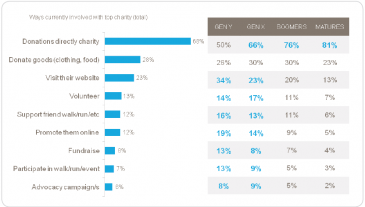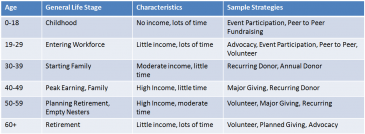Engaging Young Donors

One of the biggest challenges facing nonprofit organizations today is changes in generational giving. As boomers are moving from the workforce, where they are generating income, to retirement, organizations are exploring new ways to engage a younger group of constituents. This post will focus on some key features of younger generations and tips on how to use data to drive a stronger engagement strategy with this bunch. So who is this group and how can you best leverage resources to engage and retain them?
Younger Generations Engage with Fewer Organizations, but in More Ways
According to a study conducted in 2010 that looked at charitable habits and multichannel preferences of four different generations of constituents, The Next Generation of American Giving, younger generations tend to give similar amounts, but to fewer charities. Matures give an average of $280 to their top charity and give to an average of 6.3 charities, while members of Generation X give $272 to 4.2 charities each year.

Beyond financial contributions, more younger constituents support the organization through other ways, including participating in advocacy campaigns, walk/run events, fundraise on the organizations behalf, promote them online, and volunteering.
This is not surprising as the constituent lifecycle, teamed with advances in technology, have given even more opportunities for younger constituents to engage with the organization. A general model that I have often used looks at lifecycle and engagement opportunities to understand how constituents are acquired and retained as they progress through life:
The key to retention in these groups is fostering an easy transition or conversion from one life stage to the next, understanding when and how to ask the constituent to engage in more programs and types of engagement.
How to Foster Transition
There a number of ways your organization can develop the right plan to facilitate the right strategy to guide your constituents through the constituent lifecycle.
First, you want to know everything you possibly can about them. This can be accomplished through overlay data, including demographic information, wealth information, and psychographic data. This combination of data will allow you to build cohorts of constituents and test various strategies to convert them to the next life stage. Combine it with descriptive data about your history with the constituents to further segment your file.
Next, identify key indicators that tell you when and who is ready to transition. This is done by modeling constituent behavior of successful and unsuccessful prior conversions and applying that set of learnings to your current constituent segments.
Finally, test and test and test some more. Use testing to continue to refine your communication strategy. Each time you test, you learn a little bit more. In addition, you can identify new trends as they occur.



